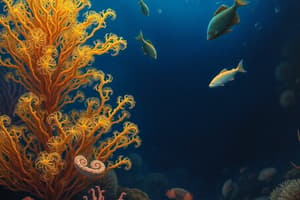Podcast
Questions and Answers
What reduces the sustainable number of larger animals at higher trophic levels?
What reduces the sustainable number of larger animals at higher trophic levels?
- Limited availability of nutrients in the photic zone
- Unidirectional flow of food and energy
- Loss of energy through respiration and consumption (correct)
- High initial herbivore grazing pressure
Why do phytoplankton require less energy for respiration compared to larger animals?
Why do phytoplankton require less energy for respiration compared to larger animals?
- They have a more efficient digestive system
- They have a lower metabolic rate
- They have a higher reproductive rate
- They have fewer bodily functions (correct)
What determines the seasonal plankton succession and bloom formation?
What determines the seasonal plankton succession and bloom formation?
- Unidirectional flow of food and energy
- Abundant light and nutrients, low initial herbivore grazing pressure (correct)
- High initial herbivore grazing pressure
- Limited availability of nutrients in the photic zone
Why is food and energy considered unidirectional as you move up trophic levels?
Why is food and energy considered unidirectional as you move up trophic levels?
Where do phytoplankton activities primarily take place?
Where do phytoplankton activities primarily take place?
Flashcards are hidden until you start studying




